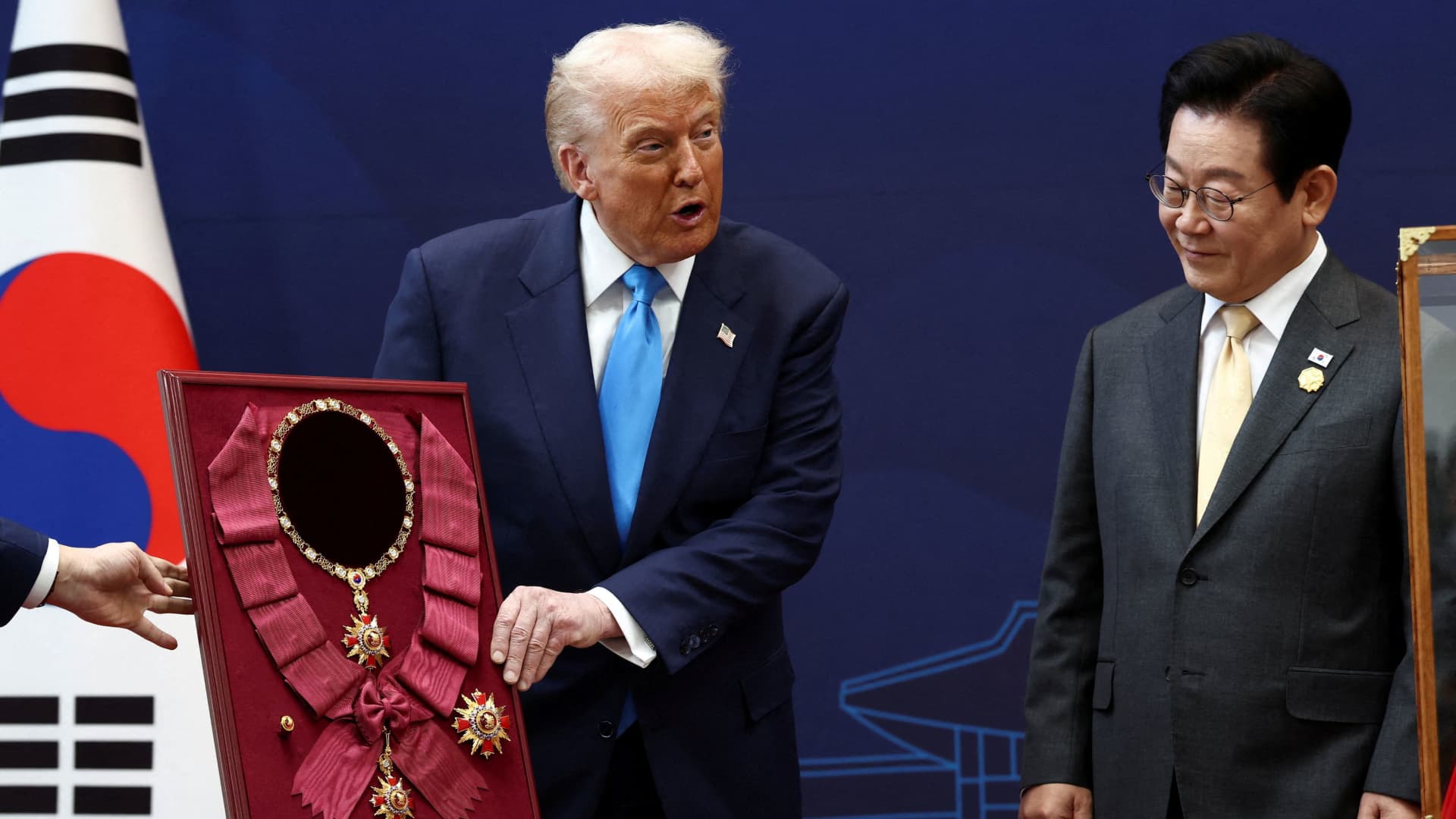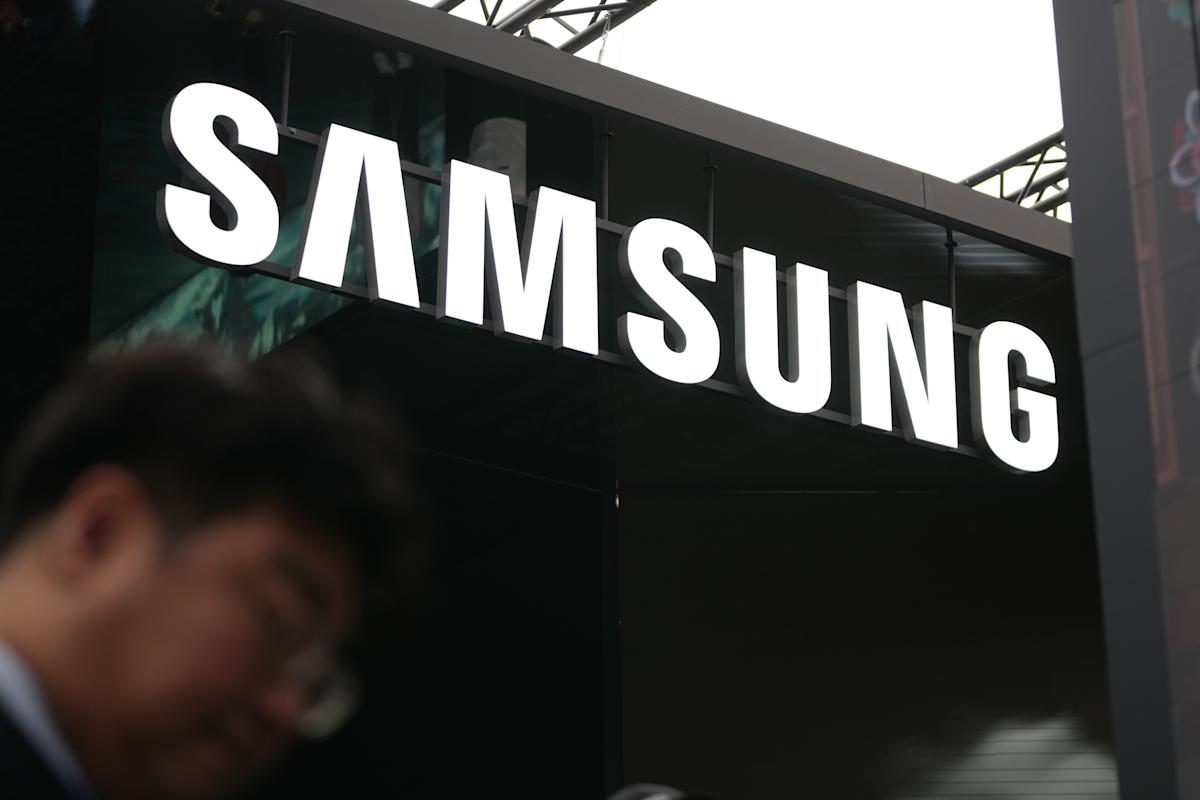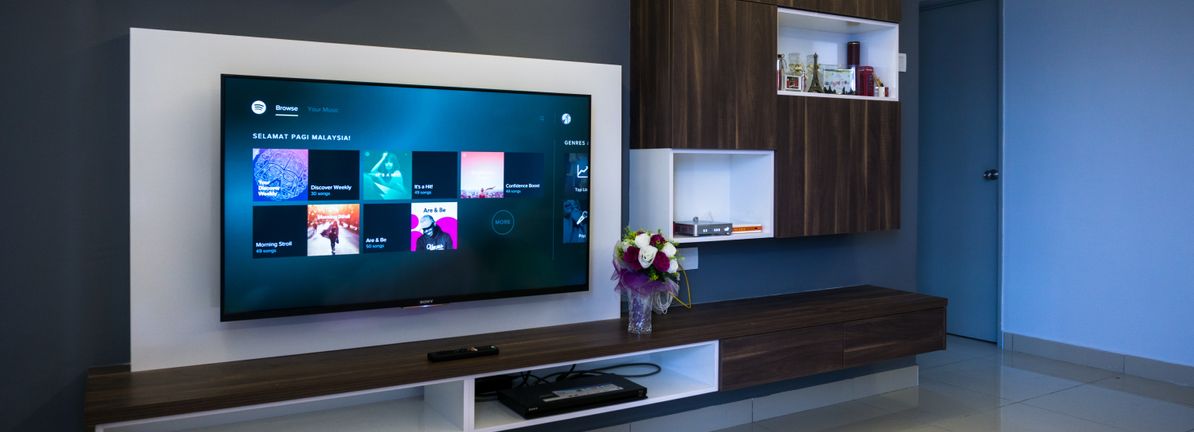Category: 3. Business
-

South Korean firms pledge domestic investments after U.S. tariff deal
U.S. President Donald Trump is presented with the “Grand Order of Mugunghwa” during a meeting with South Korean President Lee Jae Myung on the sidelines of the Asia-Pacific Economic Cooperation (APEC) leaders’ summit in Gyeongju, South Korea, October 29, 2025.
Evelyn Hockstein | Reuters
Samsung Electronics and other major South Korean companies on Sunday announced fresh domestic investment plans at a meeting with President Lee Jae Myung, who hopes the moves will counter concerns that the firms would prioritize U.S. investments under a trade deal.
Lee’s meeting with business leaders came days after his government finalized a trade deal with the United States, in which Seoul pledged to invest $350 billion in U.S. industries in exchange for averting the Trump administration’s highest tariffs.
Samsung, a global leader in computer chips, said it will invest 450 trillion won ($310 billion) over the next five years to expand its domestic operations, including building another production line at its Pyeongtaek manufacturing hub to meet surging global semiconductor demands fueled by artificial intelligence.
Samsung said the new line, set to begin operations in 2028, is part of its broader effort to secure additional production capacity in anticipation of rising mid- to long-term demands for memory chips. The company also plans to build AI data centers in the country’s southwest South Jeolla Province and the southeastern city of Gumi to support government efforts to reduce the development gap between the greater Seoul metropolitan area and other regions.
Hyundai Motor, South Korea’s largest automaker, said it plans to invest 125 trillion won ($86.3 billion) from 2026 to 2030 to expand domestic research and development and advance new technologies such as AI, robotics and self-driving cars.
SK Group, another semiconductor powerhouse, and shipbuilders Hanwha Ocean and HD Hyundai also announced plans to increase their domestic investments. Both are central to South Korean commitments to boost the U.S. shipbuilding industry, a sector highlighted by President Donald Trump in negotiations with Seoul.
In his meeting with the companies’ chiefs, Lee credited the business sector for helping his government negotiate the trade deal with Washington but urged the companies to maintain strong domestic investments to ease concerns they might cut spending at home to invest more in America. He said his government is exploring various policy steps, including easing regulations, to help create a more favorable business environment for the companies.
SK Chair Chey Tae-won, whose group plans to invest at least 128 trillion won ($88.3 billion) domestically through 2028 with a focus on AI, said the finalization of trade talks with the United States eases uncertainties and paves the way for bolder domestic investment.
The two governments released the details of the trade agreement on Friday, including $150 billion in South Korean investments in the U.S. shipbuilding sector and an additional $200 billion in other American industries. Seoul says this will be capped at $20 billion per year to prevent financial instability.
The United States agreed to reduce tariffs on South Korean cars and auto parts from 25% to 15%, and to apply tariffs on South Korean semiconductors on terms “no less favorable” than those granted to comparable competitors in the future.
Continue Reading
-

Samsung and other South Korean firms pledge larger domestic investments after US tariff deal
SEOUL, South Korea (AP) — Samsung Electronics and other major South Korean companies on Sunday announced fresh domestic investment plans at a meeting with President Lee Jae Myung, who hopes the moves will counter concerns that the firms would prioritize U.S. investments under a trade deal.
Lee’s meeting with business leaders came days after his government finalized a trade deal with the United States, in which Seoul pledged to invest $350 billion in U.S. industries in exchange for averting the Trump administration’s highest tariffs.
Samsung, a global leader in computer chips, said it will invest 450 trillion won ($310 billion) over the next five years to expand its domestic operations, including building another production line at its Pyeongtaek manufacturing hub to meet surging global semiconductor demands fueled by artificial intelligence.
Samsung said the new line, set to begin operations in 2028, is part of its broader effort to secure additional production capacity in anticipation of rising mid- to long-term demands for memory chips. The company also plans to build AI data centers in the country’s southwest South Jeolla Province and the southeastern city of Gumi to support government efforts to reduce the development gap between the greater Seoul metropolitan area and other regions.
Hyundai Motor Group, South Korea’s largest automaker, said it plans to invest 125 trillion won ($86.3 billion) from 2026 to 2030 to expand domestic research and development and advance new technologies such as AI, robotics and self-driving cars.
SK Group, another semiconductor powerhouse, and shipbuilders Hanwha Ocean and HD Hyundai also announced plans to increase their domestic investments. Both are central to South Korean commitments to boost the U.S. shipbuilding industry, a sector highlighted by President Donald Trump in negotiations with Seoul.
In his meeting with the companies’ chiefs, Lee credited the business sector for helping his government negotiate the trade deal with Washington but urged the companies to maintain strong domestic investments to ease concerns they might cut spending at home to invest more in America. He said his government is exploring various policy steps, including easing regulations, to help create a more favorable business environment for the companies.
SK Chair Chey Tae-won, whose group plans to invest at least 128 trillion won ($88.3 billion) domestically through 2028 with a focus on AI, said the finalization of trade talks with the United States eases uncertainties and paves way for bolder domestic investment.
Continue Reading
-

UPAD Launches “Rakija Gate” – The First Balkan Anti-Bot
ZAGREB, Croatia, Nov. 16, 2025 (GLOBE NEWSWIRE) — UPAD, the progressive, fintech-driven ticketing infrastructure startup, has deployed “Rakija Pit”, a culturally-coded anti-automation signal created to identify and quarantine bots during high-demand ticket launches.
Rakija Gate was activated for the first time ever during the New Year’s Eve sale for the biggest young regional singer Aleksandra Prijović, organised by Extra FM, drawing the highest complexities of bot traffic the region has ever recorded.
Within minutes, UPAD’s behaviour engine detected machine-generated purchase patterns far above normal thresholds. Instead of allowing automated sessions to compete with real fans, suspicious traffic was routed into a separate quarantine lane – an internal mechanism the engineering team calls the Rakija Pit. It’s where automated sessions can dance as long as they want – but they never reach checkout. Meanwhile, real fans keep moving forward.
The name reflects a piece of shared Balkan humour:
only real humans survive rakija – automated systems don’t stand a chance.
It’s where automated sessions can dance as long as they want — but they never reach checkout. Meanwhile, real fans keep moving forward.
Behind the jokes sits a tech-forward layer of infrastructural logic more commonly found in modern fintech than in regional ticketing.
While most platforms in the EU treat bot traffic as an inevitable nuisance, UPAD is positioning Rakija Pit as part of a new integrity layer for live-event access. As Balkan markets begin mirroring global demand waves, UPAD sees infrastructural fairness as essential.
To set a new standard for transparency, UPAD will publish a public Event Digest, including anonymized metrics such as queue composition, purchase success rates, anomaly quarantines, and overall integrity scores.
“This is what artists, organisers, and fans deserve,” said M.M. “Not mystery. Not speculation. Actual numbers. Actual fairness. Actual presence.”
upad.hr
About UPAD
UPAD is a fast-growing ticketing infrastructure company building the technological backbone for fair, transparent live experiences across the Balkans and beyond. UPAD combines modern seat architecture, behaviour-scoring, and presence-tracking layers to protect artists and fans from automated interference. With a visual language inspired by minimal systems design and a philosophy built around Be Present, UPAD aims to elevate how live events are sold, measured, and experienced.
More: upad.hr
Press Contact
UPAD d.o.o.
info@upad.hr
upad.hrA photo accompanying this announcement is available at https://www.globenewswire.com/NewsRoom/AttachmentNg/9f1569d5-c7eb-41e6-829e-377230598c64
Continue Reading
-

Tether (USDT) vs. Ripple USD (RLUSD)
-
Tether is the world’s top stablecoin, and it’s widely used across the biggest blockchains.
-
Ripple USD mainly operates within its own blockchain, but it’s useful for certain tasks.
-
Both stablecoins should stay pegged to the U.S. dollar, but one is a safer buy.
-
10 stocks we like better than Tether ›
Stablecoins are often considered safer alternatives to volatile cryptocurrencies like Bitcoin (CRYPTO: BTC). They’re usually pegged to a fiat currency like the U.S. dollar. They can be held without a bank account, be used for faster and cheaper cross-border transfers, and help people preserve their capital in countries plagued by hyperinflation.
They’re not designed to beat the market over the long term, but they can earn higher yields than traditional savings accounts across centralized and decentralized finance (DeFi) platforms. They can also fund payments on decentralized apps (dApps) across various blockchains.
Image source: Getty Images. The world’s largest stablecoins are all pegged to the U.S. dollar. At first glance, they might look identical because they’re all trading at $1 a token. But if we dig deeper, we’ll see that they’re backed by different assets and integrated into different ecosystems. Let’s review two of those popular stablecoins — Tether (CRYPTO: USDT) and Ripple USD (CRYPTO: RLUSD) — and see how their differences might make them more or less appealing to certain investors.
Tether, with a market cap of $183.5 billion, is the world’s most valuable stablecoin. It was launched by Tether Limited, a subsidiary of Hong Kong-based iFinex (which also owns the Bitfinex cryptocurrency exchange), in 2014. It was initially minted on Bitcoin’s blockchain, subsequently minted as an ERC-20 token on Ethereum‘s (CRYPTO: ETH) blockchain, and minted across other smaller blockchains as it was more widely accepted.
Ripple USD, with a market cap of $1 billion, ranks a distant ninth in the stablecoin race. It was launched by fintech company Ripple Labs, whose founders also created the XRP (CRYPTO: XRP) cryptocurrency, in 2024. It was pre-mined natively on the XRP Ledger.
Tether is more broadly used on DeFi platforms and dApps than Ripple USD. Ripple’s XRP Ledger isn’t natively compatible with Ethereum and other popular blockchains, so Ripple USD is still primarily used for money transfers within Ripple’s own payment platform.
Ripple USD is also often used as a “bridge currency” for fiat currency transfers. Instead of directly converting fiat currencies into each other — which can be slow, expensive, and inefficient — both fiat currencies are simply converted to Ripple USD (as a bridge) and converted back to their original currencies.
Continue Reading
-
-

Boeing targets industrial stability before new output rises
Boeing’s Stephanie Pope gives a press conference at the Paris Le Bourget Airport, on June 20, 2023.
Geoffroy Van Der Hasselt | AFP | Getty Images
Boeing aims to stabilize aircraft production at current levels before advancing to the next industrial milestones as it implements safety and quality improvements, its top jetmaking executive said on Sunday.
Boeing Commercial Airplanes CEO Stephanie Pope told reporters it was too early to say when Boeing would push 737 jet output to 47 a month, having recently been cleared by regulators to reach 42 a month after the lifting of temporary output curbs.
“Getting it better at (the right) pace is better than going fast,” Pope said in a briefing ahead of the Dubai Airshow.
Production milestones
Boeing won approval last month to raise 737 output to 42 per month, easing a 38-plane cap in place since a 2024 mid-air blowout caused by missing bolts in a door plug. The incident revealed widespread safety and quality lapses at Boeing.
The U.S. planemaker is now producing 42 of the jets a month and is on the brink of reaching eight a month on the 787 model.
“My initial focus is stabilizing at those two rates,” Pope said, adding this would involve meeting six targets agreed with the Federal Aviation Administration, including keeping tabs on supplier shortages and out-of-sequence work.
The trend in such industrial glitches is falling, Pope said.
Asked when the next milestones of 47 a month for the 737 and 10 for the 787 could be reached, Pope said, “I cannot put a definition on it … we’ll go up in rate when the system is ready to go up in rate.”
New ‘North line’ at Everett factory
After decades of producing 737s at its Renton factory, south of Seattle, Boeing is setting up a new “North line” in its cavernous wide-body Everett factory north of the city to accommodate higher production of the narrow-body jet.
Pope said this would not be needed until Boeing takes the next step towards pre-Covid levels of 52 a month.
Asked whether Boeing would then follow Airbus even higher, Pope said: “My near-term focus is one rate break at a time.” But she added that part of the thinking behind extra capacity “is so we can meet the market and meet our customers’ demand long term.”
Boeing has fallen industrially well behind Airbus, partly due to the success of its European rival’s A321neo and partly because of a series of safety and industrial mishaps on its 737 series, which generates most of the company’s cash.
Airbus is producing 63 of the wider A320neo-family jets per month and plans to reach 75 per month by 2027, although some suppliers have questioned whether this is achievable.
Analysts say the production plans are critical for both companies as Boeing repairs its finances and Airbus attempts to build up a war chest for the next generation of planes.
Continue Reading
-

Airbus says Middle East regional aircraft to more than double by 2044
DUBAI, Nov 16 (Reuters) – Airbus expects the Middle East’s regional aircraft fleet to more than double to 3,700 planes by 2044, an official said on Sunday.
The European planemaker expects passenger traffic in the Middle East to grow at a compound annual rate of 4.4% over the next two decades, Airbus Head of Marketing in Africa and the Middle East Grainne van den Berg told a press conference.
Sign up here.
Airbus also expects the services market in the region to double to $29.9 billion by the end of 2044, van den Berg added.
The forecast came ahead of the Dubai Airshow, the largest Middle East aviation event taking place on November 17-21.
Airbus, which is among the planemakers taking part as it vies for orders with its main competitor Boeing (BA.N), predicts widebody aircraft will make up 42% of total demand in the region by 2044, representing the highest share globally.“The Middle East is transforming global aviation, and the forecast fleet expansion is truly significant, particularly when it comes to widebodies,” said Airbus President in Africa and Middle East Gabriel Semelas.
“This region is becoming the long-haul hub now and into the future,” Semelas added.
Reporting by Federico Maccioni and Ahmed Elimam in Dubai; Writing by Menna Alaa El-Din in Cairo; Editing by Andrew Heavens and Alexander Smith
Our Standards: The Thomson Reuters Trust Principles.
Continue Reading
-

What investors need to know
Gold traded below the $4,000-per-ounce mark again on Tuesday as the dollar remained resilient at over three-month highs, while reduced chances of another U.S. interest rate cut in December and easing U.S.-China trade tensions blunted bullion’s demand.
Bloomberg | Bloomberg | Getty Images
Gold profits are glittering in 2025 — but cashing in may trigger a bigger tax bill than you might think.
The price of gold futures hit $4,000 per ounce in October, for the first time ever. While the precious metal dropped in price on Friday as part of a broader market decline, year-to-date returns still sat at nearly 50%, with a price around $4,100.
Exchange-traded funds backed by physical gold — like SPDR Gold Shares (GLD), iShares Gold Trust (IAU), and abrdn Physical Gold Shares ETF (SGOL) — are up by a similar amount.
By comparison, the S&P 500 U.S. stock index is up about 15% in 2025, as of Friday’s close.
Heady returns in 2025 follow a year in which gold recorded its best annual performance since 2010, about 26%, according to the World Gold Council.
But investment profits from physical gold and funds that track gold are taxed differently from those of traditional assets like stocks and bonds, according to tax experts.
The upshot is that investors — especially those in the top tax brackets — may pay a higher federal tax rate on gold profits relative to assets like stocks and bonds.
That could leave gold investors with a surprise tax bill.
“I’ve seen missteps quite a few times, especially this year with the run that gold has had,” said Tommy Lucas, a certified financial planner and enrolled agent at Moisand Fitzgerald Tamayo, which was No. 69 on the CNBC’s Financial Advisor 100 list for 2025.
Not all gold ETFs are taxed the same
“Long-term” tax rates on investment profits — known as capital gains — are preferential relative to the marginal income tax rates that investors might pay on wages and other income, for example.
For example, the top federal rate on long-term capital gains, 20%, is lower than the top marginal income tax rate, 37%.
Long-term capital gains rates apply when an investor has owned an asset for more than one year.
However, physical gold and funds backed by physical gold are treated as collectibles for tax purposes — and collectibles have a top 28% rate on long-term capital gains.
“There’s no getting around that [collectibles rate] just because it’s held in an ETF wrapper,” Lucas said.
This also applies to other precious metals like silver.
Funds that hold gold futures contracts — instead of physical gold — have yet a different tax structure, with a top federal tax rate of 26.8%, said Jeffrey Levine, a certified public accountant and certified financial planner based in St. Louis.
“Just because you have a gold ETF doesn’t mean it’s going to be taxed exactly the same,” said Levine, the chief planning officer at Focus Partners Wealth.
In both cases — collectible and futures — investors in the top tax bracket would pay a higher rate on long-term profits than a traditional asset like a stock, he said.
Of course, this tax discussion only applies to gold held in a taxable brokerage account and sold for a profit. It doesn’t apply to investors who hold gold ETFs in a tax-preferred retirement account, like an IRA.
Breaking down tax on collectibles and futures
There are three long-term capital-gains rates: 0%, 15% and 20%, depending on an investor’s annual income.
Short-term capital gains, which apply to assets held for a year or less, are different. Profit on such sales is taxed at ordinary income tax rates, like those that apply to wages, for example. There are seven marginal tax rates, ranging from 10% up to 37%.
Collectibles are taxed like short-term capital gains but are capped at 28%. That means an investor in the 32%, 35% or 37% income tax brackets wouldn’t own more than 28% in long-term capital gains on collectibles profits.
I’ve seen missteps quite a few times, especially this year with the run that gold has had.
Tommy Lucas
certified financial planner and enrolled agent at Moisand Fitzgerald Tamayo
Meanwhile, capital gains for futures contracts are assessed based on a 60/40 tax structure, said Levine. That is, 60% of their profits are taxed as long-term capital gains, and the remaining 40% as short-term capital gains.
In the case of gold futures funds, here’s how the math works for someone in the top tax bracket: 60% of 20%, which is the top long-term rate for capital gains, is 12%; and 40% of 37%, the top marginal income tax rate, is 14.8%.
Added together, that’s a top capital-gains rate of 26.8% for gold futures contracts, Levine said.
While some higher-income investors might think it’s a better idea from a tax perspective to buy gold futures funds, there are also downsides, he said.
For example, such investors would get a K-1 tax form since the funds are often structured as partnerships, Levine said. That could make it more challenging and costly to file an annual tax return, he said.
Continue Reading
-

Assessing Sea Limited’s Value After Recent Southeast Asia Expansion News
-
Wondering if Sea is a smart buy or overpriced right now? You are not alone. Figuring out its true value is one of the biggest questions investors are asking.
-
Despite a recent 6.1% dip over the past week and a 12.0% decline in the last month, Sea is still up an impressive 34.3% this year and 36.8% over the past 12 months.
-
Sea’s stock price has been on a rollercoaster as the company continues to make strategic moves in e-commerce and digital financial services, keeping it in the headlines. Recent reports on expansion into new Southeast Asian markets and pivotal partnerships with local firms have fueled both excitement and caution among investors.
-
Based on our checks, Sea scores a 3 out of 6 for value. This means it appears undervalued in about half of the key areas we assess. Next up, we will break down how different valuation methods measure Sea’s worth and, if you stick around, reveal a smarter way to interpret what these numbers truly mean.
Sea delivered 36.8% returns over the last year. See how this stacks up to the rest of the Multiline Retail industry.
A Discounted Cash Flow (DCF) model estimates a company’s intrinsic value by projecting its expected future cash flows and then discounting those cash flows back to today’s dollars. This approach aims to determine what a company is truly worth based on the cash it can generate in the future.
For Sea, the current Free Cash Flow (FCF) stands at $3.58 Billion, providing a solid foundation for further growth. While analysts cover cash flow projections for the next five years, projections beyond that (out to 2035) are extrapolated. This offers an extended glimpse into Sea’s potential. In 2029, Sea’s FCF is expected to reach $7.80 Billion, indicating robust anticipated growth.
Using all projected figures and discounting those future cash flows back to their present value, the DCF model calculates Sea’s intrinsic value at $313.84 per share. Compared to the current market price, this implies the stock is trading at a 55.1% discount. This suggests Sea is significantly undervalued by this measure.
Result: UNDERVALUED
Our Discounted Cash Flow (DCF) analysis suggests Sea is undervalued by 55.1%. Track this in your watchlist or portfolio, or discover 886 more undervalued stocks based on cash flows.
SE Discounted Cash Flow as at Nov 2025 Head to the Valuation section of our Company Report for more details on how we arrive at this Fair Value for Sea.
The Price-to-Earnings (PE) ratio is a widely used valuation tool for profitable companies like Sea, as it relates a company’s share price to its actual earnings. It is particularly relevant for investors because it helps gauge how much the market is willing to pay today for a dollar of the company’s annual earnings.
Continue Reading
-
-

4 historic train stations reimagined as luxury hotels
After an extensive six-year, 50bn-yen ($324m/£ 246m) renovation, the Tokyo Station Hotel reopened in 2012 as a 150-room property and a member of the Small Luxury Hotels of the World collective. It prides itself on blending omotenashi (the traditional Japanese concept of hospitality) with modern luxury.
Guests can admire the hotel’s vaulted ceilings and European-style architecture alongside contemporary amenities such as the AN SPA and 10 on-site restaurants.
 General Hotels Corporation
General Hotels CorporationCrowne Plaza Indianapolis Downtown Union Station has some of the most unique rooms of any train station hotel (Credit: General Hotels Corporation) Crowne Plaza Indianapolis Downtown Union Station, US
Opened in 1853, Indianapolis Union Station was the first “union station” in the United States, pioneering the concept of a single, shared terminal for multiple railroad lines. Today, the Crowne Plaza Indianapolis has paid homage to that legacy by converting 26 Pullman train carriages into special guest rooms.
Climbing the narrow steps into a glossy blue-and-gold private carriage brings guests into a suite-like space lined with train windows and burnished gold fixtures. Outside each room stand statues depicting railway workers from the early 1900s.
In addition to the unique rooms, the National Historic Landmark hotel offers easy access to downtown attractions, including Lucas Oil Stadium and Gainbridge Fieldhouse.
—
If you liked this story, sign up for The Essential List newsletter – a handpicked selection of features, videos and can’t-miss news, delivered to your inbox twice a week.
For more Travel stories from the BBC, follow us on Facebook and Instagram.
Continue Reading
